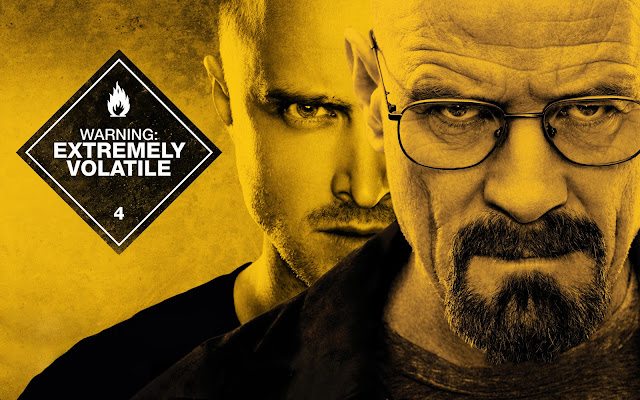It's about time for another update on the Wanna Cook? The Unofficial Guide to Breaking Bad project, so, since I've finished an annotating re-watch of Season 1, I thought I'd ruminate on some of what struck me as I watched these first seven episodes again. So, for those of you who haven't seen Season 1, or even Seasons 2 - 4:
!!!SPOILER ALERT!!!
 |
| Cooking in the Scrub Desert |
To start with some of those production values, the camerawork in Breaking Bad readily comes to the fore, and with good reason. In the DVD commentaries for this season Dean Norris (who plays DEA agent Hank Schrader in the show) notes early on how "filmic" the production values on the series are. (I don't think it's inappropriate to refer to the camera-work as cinematography, though with the wonderful proliferation of Quality TV out there right now, we really need a new word for high-quality, carefully constructed, artistic camera-work on TV, the "art of making television" rather than movies. Televideography?) Breaking Bad is filmed like a movie, not as we are used to seeing TV shows, with limited camera angles and perspectives, but with a proliferation of viewpoints and shot-angles which become part of the narrative itself.
Time-lapse film-work leaps to mind here. Taking advantage of the dramatic scenery, wide-open spaces, and beautiful skies over the New Mexico desert, Gilligan and Co. do a brilliant, visually stunning job of incorporating the passage of time into their story. I'm thinking particularly of the shots of the RV, yellow smoke streaming from the roof-vents as Walt and Jesse (or Jesse and Badger!) cook, while around it, in sequences that are viewed in merely seconds, the sky changes, sun sets and rises, clouds stream by, the scrub and prairie grasses are blown about by the winds, and shadows flow, grow, ebb, and grow again as 24 or more hours of film (or more likely digital recordings) are run up to a high speed, turning the accomplishments of many hours into a moment. (My apologies to Shakespeare, but if you're gonna steal, steal from the masters!). Just beautiful stuff!
Perhaps the shot I most associate with Breaking Bad however, is the up-and-through-from-under angle. I'm sure there's a technical name for this shot, but I don't know it - yet. What I'm talking about are those wonderful angles where we get a bottom-up view of the action, usually seeing "through" a solid surface.: as Jesse tosses Emilio's body into the tub and splashes hydrofluoric acid over it while bemoaning his situation in a hilarious soliloquy, in the cold open of "...And the Bag's in the River," when we see this weird reddish stuff covering the screen, which is revealed to be the partially liquefied remains of Emilio as Walt swipes an arc through the mess, allowing us to look up at him on hands and knees in a filtered breath mask as he cleans up the sludge that was once a human being. You'll see this shot used judiciously again and again throughout the series, and it never fails to grab the attention.
Gilligan and Co. also do some really wonderful, subtle work with parallel shots in Season 1. Consider Walt waking up on the bathroom floor after the credits for "The Cat's in the Bag..." The scene opens with a view of Walt, eyes closed, his face pressed against a hard surface, and the shot angled vertically (the top of Walt's head at the top of the screen rather than to the side). He wakes, startled, rises up as we reorient to realize that he was laying on the floor after all, and wipes his mouth where he has drooled in his sleep. This same shot and waking sequence is repeated in the next episode "...And the Bag's in the River" when Walt regains consciousness in Jesse's basement after passing out during a coughing fit as he brings lunch to the chained Crazy 8. This parallelism is a brilliant connecting conjunction in Walt's life, showing us that no matter what's going on, what acts and situations Walt goes through, it's all being done/experienced by the same, all too human guy, who drools in his sleep.
Okay, I think I'll wrap this up now, though I had intended to go into some more stuff, particularly the early set up of Hank Schrader's character as the series' really good guy, the wonderful married-couple chemistry between Bryan Cranston (Walt) and Anna Gunn (Skylar), and what the hell a javelina is, but this post has gone on long enough I think. In any event, Season 1 is re-watched and many notes taken, so now it's on to Season 2, where things get even better!


